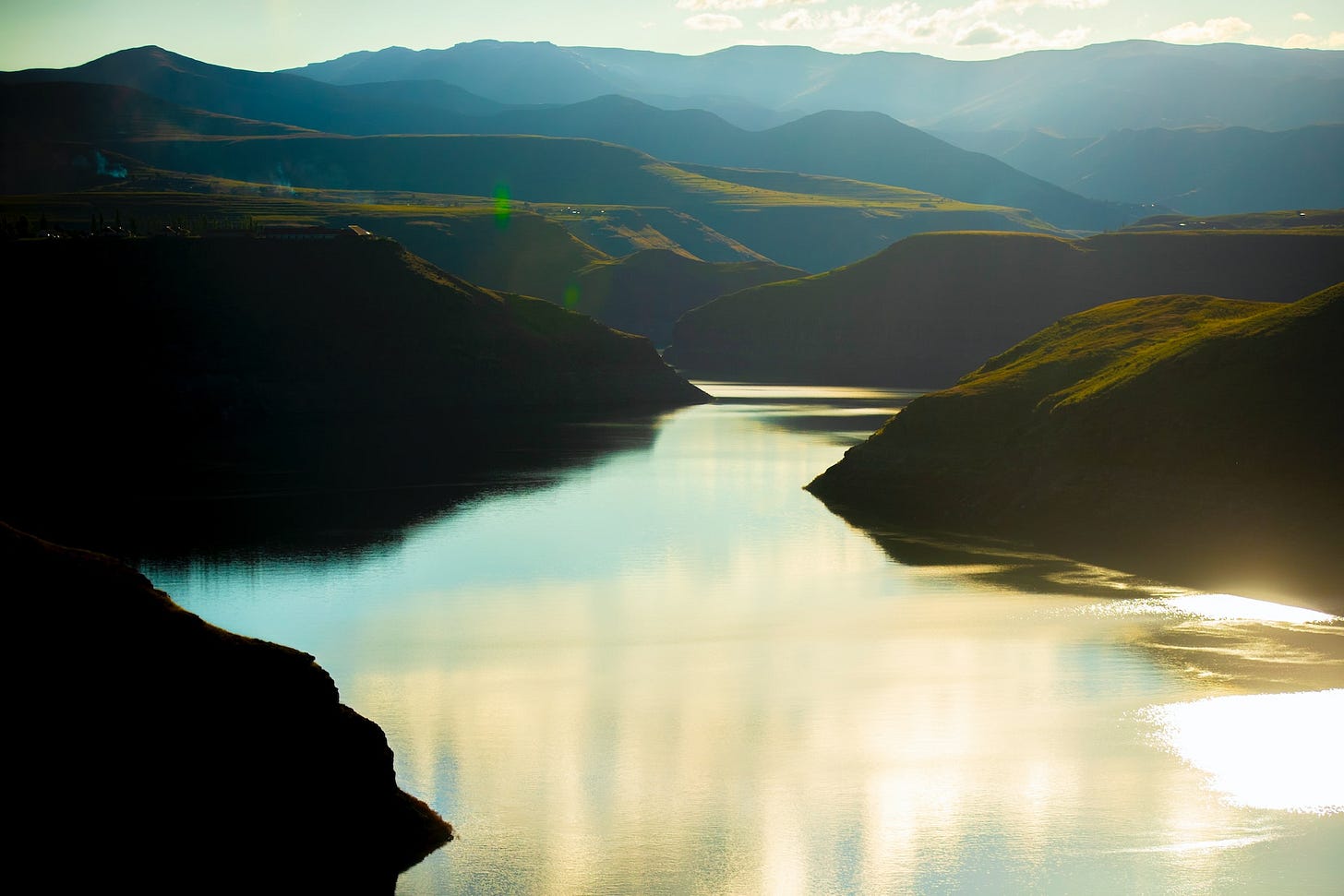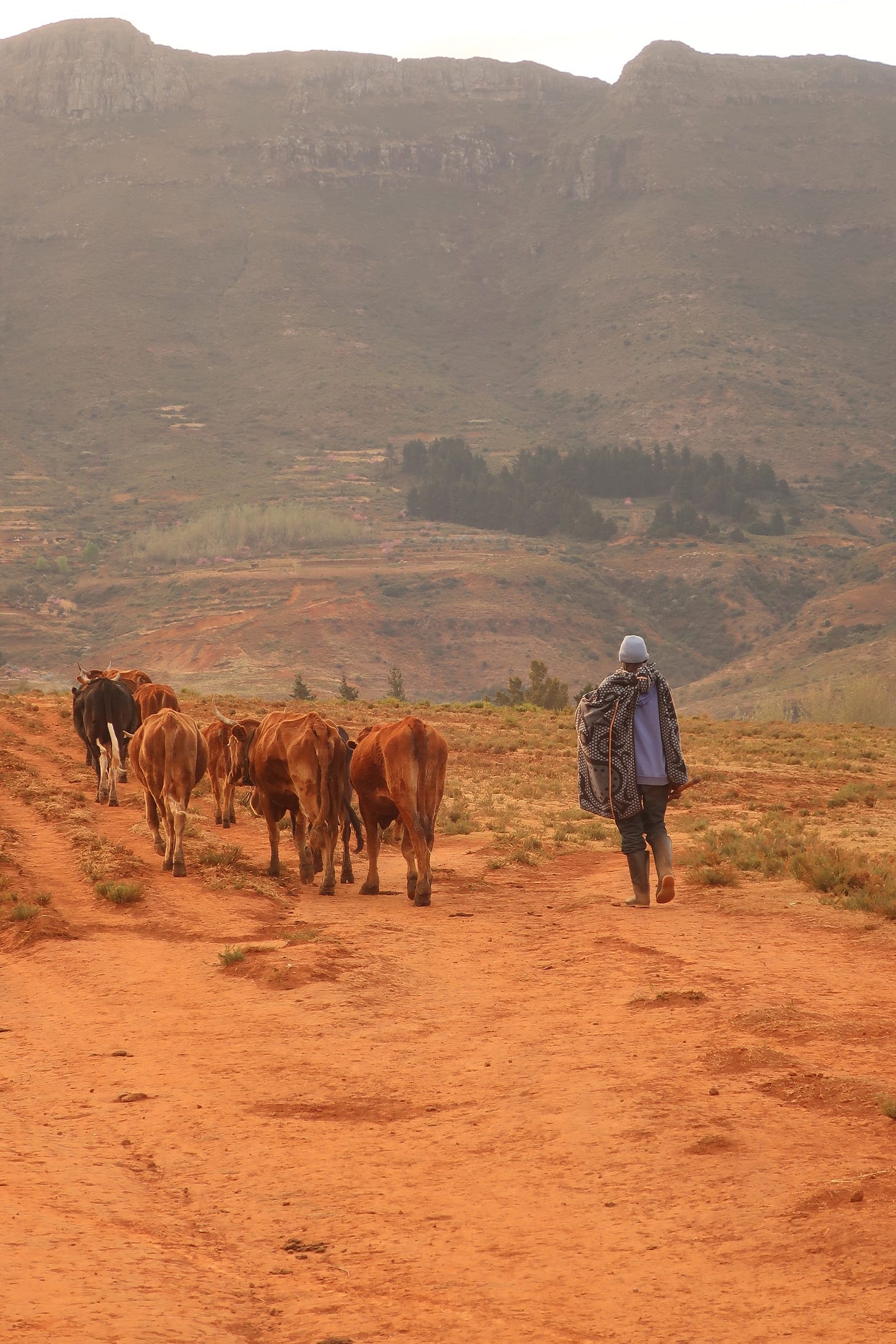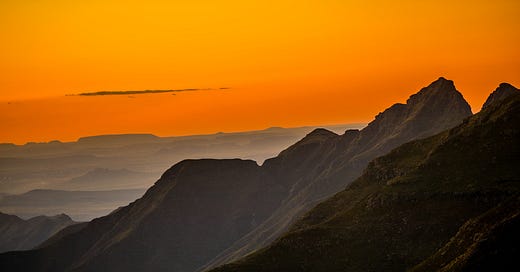Welcome to Cosmographia. The following is part of our Atlas’ Notes series, featuring art, poetry, literature, cartography, and photography, all centred on a particular place. For the full map of Cosmographia posts, see here.
Lesotho is a small landlocked country in southern Africa, home to 2 million people. Largest of the world’s three nation states to be totally surrounded by one other country (the other two being Vatican City and San Marino), its mountainous terrain makes it the only nation in the world to lie entirely above 1000m.
King Moshoeshoe I first united the Basotho tribes in the early 1820s to form what was then known as Basutoland, high up on the plateau of the Great Escarpment of Southern Africa. Continuous encroachments by the Boers led the King to enter an agreement with the British Empire to become a protectorate in 1868. Lesotho became an independent country in 19661, and remains a constitutional monarchy to this day.
Lesotho is considered a lower middle income country, with half the population remaining below the poverty line, and suffering the second highest rate of HIV/AIDs in the world. Despite this, a strong tradition of primary education means it has one of the highest literacy rates in Africa (>80%), and, as you’ll see below, has produced some remarkable art and culture.
I. In Art
The San peoples of Southern Africa are indigenous hunter-gatherer societies, and among the oldest surviving cultures in the world. The term ‘San’ was originally a derogatory exonym put upon them by their neighbours, the pastoralist Khoekhoe, but is now preferred to the old European term, ‘Bushmen’. In fact, the San are made up of many individual nations, such as the !Kung, |Xam, and Kxoe. There are very few San people left in Lesotho now, but the Sotho —the ethnic group making up 99.7% of the country— are descended from a mix of San and Bantu-speaking clans who moved into the area around 500 AD.
This millennia-old rock art, thought to have been created by a San people, can be found inside a cave in the Drakensberg Mountains — the eastern part of the Great Escarpment of the Southern African Plateau. This huge ridge marks the eastern boundary between Lesotho and South Africa, and contains one of the highest concentration of prehistoric rock paintings in the world.
The eland holds a special place in many San cultures. For the !Kung, for instance, a boy must hunt and kill an eland as part of his coming of age ceremony. After shooting the world’s largest antelope —which can weigh up to 940kg— with a poisoned arrow, the boy must return to his camp, start a fire, and rub the ashes onto his forehead and down his nose — emulating the markings on an eland’s brow. The next day the boy tracks the animal to the kill. If successfully found, there proceeds a medicine dance and parts of the eland are cooked. On return to the camp, the boy is congratulated and scarified. The child is considered dead; the boy has become a hunter.
II. In Verse
I am a descendant of Howana, of the family of Tlalane, Descendant of Mahase, son of Mpewana, I scatter the cattle, I scatter the people too, I scatter even the small black wildebeests in the veld, I am a young lion of Tsebela descendants. A vulture does not eat me, lightning having struck me, Fearing it would ooze from the mouth!— Bafokeng, Moipone Mofokeng (dates to 19th century at least, but perhaps further back)
This is an example of a diboko poem, an oral tradition used as a history and distinguisher between Sotho clans.
The Sotho people believe themselves to originate from a mythical hillock somewhere in the East known as Ntswanatsatsi, where the sun rises. It was here the tribes were given a totem name to distinguish one from the other. Hence, the importance of the diboko to its tribe — it defines who they are. This particular tribe associate with the lion — surely the coolest of the great animals of the savannah.
III. In Cartography
This map comes from a book titled The Gold Fields Revisited, Being Further Glimpses of the Gold Fields of South Africa. This 1887 book, available to read online via the British Library, or in chunky hardback on Australian Amazon for a hefty sum of $802, is an incredibly boring account of Edward Peter Mathers second journey (somehow this book is a sequel) touring the gold fields of Southern Africa. He travels from Barberton to the Witwatersrand, Swaziland, and Matabeleland in Zimbabwe. From what I can tell, Mathers wrote two entire books in an effort to reassure his investors that there was indeed a lot of gold in this part of South Africa, and to whip up excitement further with an eye to gain further financial backing (I believe the term for this is shilling one’s portfolio).
Indeed, in one passage, Mathers quotes a certain Mr. Thomas Baines as saying:
“To those who have up their minds to work, who possess a trifle to keep them from poverty during their noviciate, and who, above all, possess the Englishman’s inability to acknowledge himself between, I say — Come! — make your way to the gold digger gas by this or any of the roads now open…”3
And come they did, for around this time there commenced what became known as the “Witwatersrand Gold Rush“. This, the largest gold rush in history, led to the establishment of the city of Johannesburg, and to the second Boer War, when tensions between the influx of British prospectors led to conflict with the autonomous Boer Republics. After 3 years and 200,000 dead, the British gained full control of the Orange Free State and the Transvaal, which we can see from this map were home to most of the gold deposits.
Lesotho is here labelled as Basutoland, the original name for the small country. The fact there’s no gold lying beneath the Lesothian earth is probably a blessing in disguise. Woe betide the African nation bestowed with gold.
IV. In Literature
“When a person is said to have died, he is not dead, he is merely transformed, the breath of life having left this covering of flesh and migrated to another land which shines more gloriously than the sun, and he goes and lives there exactly as he had done before, as you yourself can indeed testify to some extent because you heard for yourself your own father’s voice when he spoke to you, and it was exactly as you had known it. He who has worked hard in this world will reap a rich harvest there; one who has done nothing here will receive nothing there, because everything a person does in this world the sun takes with it when it sets and carries it to that great land of the living whom you regard as dead, and refer to as the dead; and all these things will wait for him there, growing and increasing like cows which calve repeatedly.”
— Thomas Mofolo, Chaka (1925)
Thomas Mofolo’s Chaka is undoubtedly one of the earliest major contributions from an African author to modern world literature. Considered a masterpiece of historical realism, this book, originally written in the Sesotho language, is a fictional account of Shaka, King of the Zulus.
The bastard son of a minor Zulu chief, Shaka united the Zulu tribes into a single empire and waged genocidal wars on his neighbours. This resulted in the Mfecane, or ‘Crushing’ — a cascade of demographic movements across Southern Africa as disparate tribes fleeing his spear caused a chain reaction of war and scattering as far north as modern-day Zambia.
The Sotho call this period Lifaqane, and it played a significant role in the initial formation of what would become Lesotho. It was during this maelstrom of war and death that King Moshoeshoe first united the Sotho people, and Basutoland emerged as a single unified polity. The Sotho were thus able to resist the waves of violence wrought by the Zulus from the refuge of their mountainous terrain.
V. In Photography





“A fight between grasshoppers is a joy to the crow.”
— Lesotho Proverb
I don’t know what that converts to in British pound sterling, except that it’s far too much.
Yes, I’m quoting this passage in part because I wanted to have something to show for reading so much of this incredibly dull book.















Thank you for such a loving portrait of a people, not simply a location on a bloodied map.
Haha love the extended aside. 6 hours well spent in my opinion-- keep up this labor of love!